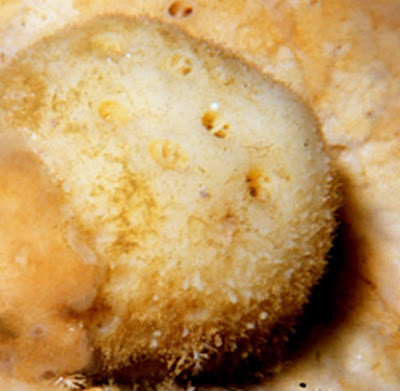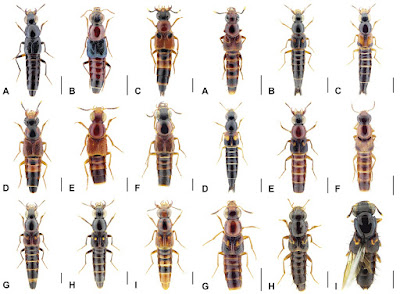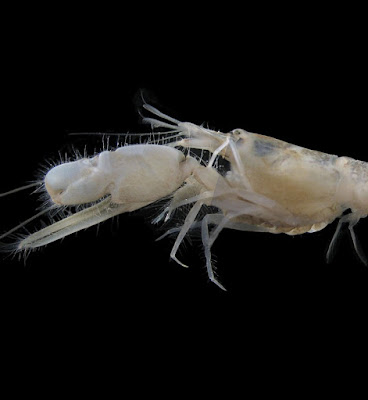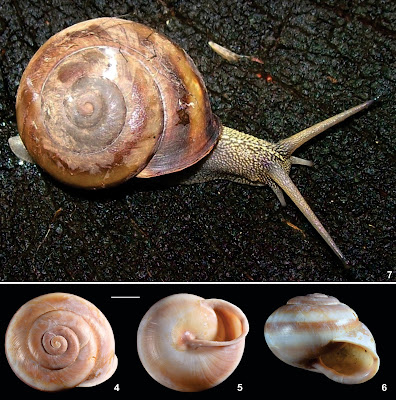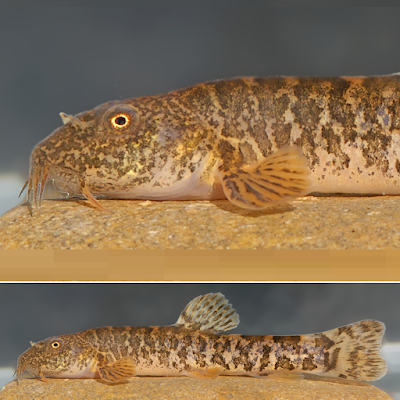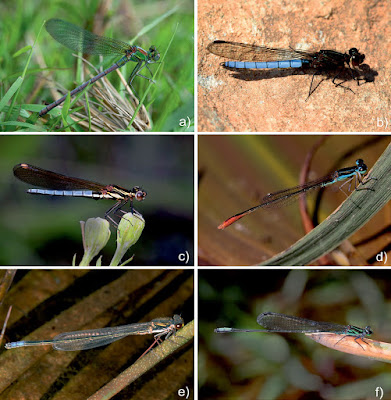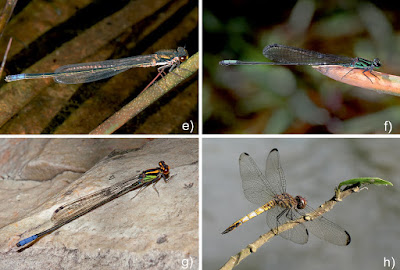[Most Recent Entries] [Calendar View]
Sunday, April 30th, 2017
| Time | Event | ||||
| 2:30p | [Porifera • 2017] Cinachyrella anatriaenilla • A New Tetillid Sponge with Microacanthoxeas from American Samoa in the South Pacific
Abstract Several sponges from American Samoa, collected by the Coral Reef Research Foundation, Republic of Palau, were tentatively identified by one of us as Acanthotetilla cf. seychellensis (Thomas 1973), due to the possession of relatively small acanthose oxeas, compared to those of other species of the genus Acanthotetilla Burton 1959. These sponges were later compared to Cinachyrella australiensis (Carter 1886), taking into account the lack of conspicuous spination on the acanthose oxeas and general features of spiculation and skeletal organisation. The specimens were later considered to represent a new species of the genus Cinachyrella Wilson 1925, after a careful comparison was made between the American Samoan specimens and C. australiensis which also contains small acanthose oxeas. Several recent molecular phylogenetic studies have confirmed the generic assignment of one of the American Samoan specimens as belonging to Cinachyrella. Cinachyrella anatriaenilla sp. nov., described herein, is the fifth of 40 Cinachyrella spp. that contain lightly spined microacanthoxeas. Keywords: Porifera, Tetractinellida, Spirophorina, Tetillidae, Acanthotetilla, new species
Etymology. Named for the possession of highly characteristic small anatriaenes (anatriaene + illa— female adjectival suffix in Latin related to diminutive of a name). Julio C.C. Fernandez, Michelle Kelly and Lori J. Bell. 2017. Cinachyrella anatriaenilla sp. nov., A New Tetillid Sponge with Microacanthoxeas from American Samoa in the South Pacific. Zootaxa. 4258(1); 81–90. DOI: 10.11646/zootaxa.4258.1.6 | ||||
| 2:49p | [Entomology • 2017] A Revision of the Oriental Species of Bolitogyrus Chevrolat (Coleoptera, Staphylinidae, Staphylininae) Abstract The Oriental species of the relictual genus Bolitogyrus are revised based on 200 specimens. An updated description of the genus is provided, including additional putative synapomorphies. Fifty valid Oriental species are diagnosed herein and the following nineteen are described as new to science: B. concavus sp. n.; B. confusus sp. n.; B. himalayicus sp. n.; B. khasiensis sp. n.; B. luteus sp. n.; B. mulayitensis sp. n.; B. nanus sp. n.; B. nokrek sp. n.; B. pecki sp. n.; B. pederseni sp. n.; B. phukhieo sp. n.; B. rougemonti sp. n.; B. sepilok sp. n.; B. schillhammeri sp. n.; B. smetanai sp. n.; B. solodovnikovi sp. n.; B. temburong sp. n.; B. tigris sp. n.; and B. tumidus sp. n. The following synonymies are proposed: Cyrtothorax borneensis Cameron, 1942, syn. n. = Cyrtothorax caesareus Bernhauer, 1915; Cyrtothorax octomaculatus Cameron, 1937 syn. n. = Quedius ornatipennis Wendeler, 1927. Quedius (Raphirus) ornatipennis is moved to Bolitogyrus as B. ornatipennis (Wendeler), comb. n. A lectotype is designated for Cyrtothorax rufipennis Cameron, 1937. Several species are named in recognition of conservation efforts to protect tropical primary forests in Asia that are important to the survival of many Bolitogyrus species. All available bionomic and distributional data for Oriental Bolitogyrus are summarized, and an identification key is provided. Keywords: Staphylinini, Cyrtoquediina, boreotropics, Asia, taxonomy, primary forest Adam J. Brunke. 2017. A Revision of the Oriental Species of Bolitogyrus Chevrolat (Coleoptera, Staphylinidae, Staphylininae). ZooKeys. 664: 1-97. DOI: 10.3897/zookeys.664.11881 | ||||
| 2:55p | [Botany • 2017] More New Rattans (Calamus, Arecaceae) from New Guinea and the Solomon Islands
Abstract As part of current research on the taxonomy of the palms (Arecaceae or Palmae) of New Guinea, ten new species of the rattan genus Calamus are described and illustrated here: Calamus baiyerensis, Calamus capillosus, Calamus erythrocarpus, Calamus heatubunii, Calamus jacobsii, Calamus katikii, Calamus kostermansii, Calamus papyraceus, Calamus pintaudii and Calamus superciliatus. An eleventh species, Calamus novae-georgii, from the neighbouring Solomon Islands is also included here. The palm flora of New Guinea now includes 62 species of Calamus, 34 of which have been described since 2002, demonstrating the remarkable scale of botanical discovery on the island. Key words: Calamoideae, Indonesia, lianas, Palmae, palms, Papua New Guinea, Papuasia, South-East Asia Taxonomic treatment 1. Calamus baiyerensis W.J.Baker & J.Dransf., sp. nov. Type:—PAPUA NEW GUINEA. Western Highlands Province: Baiyer River Subdistrict, Rouna River (Baiyer River valley) near Kambukom village, 1160 m, 23 July 1971, Zieck NGF 36252 (holotype CANB!, isotypes BH, LAE). Diagnosis:— Distinguished by the very robust, clustering habit, the sparsely armed sheath with patchy dark indumentum, the ocrea encircling the stem that disintegrates into fibres and the very robust inflorescence with robust rachillae with funnel-shaped bracts. Etymology:— The species epithet reflects the type locality in the Baiyer River valley. Distribution:— Known only from the type locality in the Baiyer River valley, Western Highlands Province, Papua New Guinea. 2. Calamus capillosus W.J.Baker & J.Dransf., sp. nov. Type:— INDONESIA. West Papua Province: surroundings of Ayawasi, ca. 450 m, 28 July 1995, Ave 4048 (holotype L!, isotype BO). Diagnosis:— Distinguished by the sheaths densely armed with very fine, hair-like spines, the regularly pinnate leaves with numerous bristles on veins and margins, the very long flagelliform inflorescences, the long, unbranched peduncle, the lax primary branches, and the staminate inflorescence branched to only two orders. Etymology:— The species epithet refers to the very hairy appearance of the leaf sheaths, due to the abundance of fine, hair-like spines, and the numerous hair-like bristles on the leaflets. Distribution:—Known only from the type locality near Ayawasi in the Bird’s Head Peninsula. 3. Calamus erythrocarpus W.J.Baker & J.Dransf., sp. nov. Type:— PAPUA NEW GUINEA. Central Province: Sogeri Subdistict, near Jawarere (Subitana), 450 m, 3 September 1968, Zieck NGF 36176 (holotype LAE!, isotype BH, L!) Diagnosis:— Distinguished by the moderately robust, clustering habit, the subcirrate leaf with few broadly lanceolate, cucullate leaflets, the longest leaflets at the base of the leaf, the leaf apex bearing a vestigial leaflet pair remnant or a short cirrus, the leaf sheaths armed only with few, minute spines, the short inflorescences lacking peduncular bracts, the rachis bracts significantly exceeding the primary branches and splitting to the base (not tattering), and the rounded red fruit covered with unchannelled, erose-margined scales. Etymology:— The specific epithet refers to the red colour of the fruit. Distribution:— Known from many gatherings at a single locality in hills 35 km east of Port Moresby, Central Province. Habitat:— Rain forest on lower slopes and bottom of a creek valley, ca. 460 m. FIGURE 8. Calamus novae-georgii. A. Leaf sheath. B. Leaf apex. C. Mid-leaf portion. D. Infructescence apex with primary branch. E. Staminate rachilla. F. Staminate flower bud in longitudinal section. G. Staminate flower bud. H. Fruit attached to pisillate rachilla, showing stalk-like first bracteole. I. Seed whole and in longitudinal section. Scale bar: A, D = 3 cm; B, C = 4 cm; E = 5 mm; F, G = 2.2 mm; H, I = 7 mm. A–D, H, I from Qusa 124; E–G from Qusa 123. Drawn by Lucy T. Smith. 4. Calamus heatubunii W.J.Baker & J.Dransf., sp. nov. Type:— INDONESIA. West Papua Province: Kota Sorong, Klasaman km 14, Klasagan, 50 m, 2 February 2013, Baker et al. 1392 (holotype K!, isotypes AAU!, BO!, BRI!, L!, MAN!). Diagnosis:— Distinguished by the few, broad, leathery leaflets, typically arranged in a single, divaricate group, the well-developed, purple-brown ocrea armed with numerous, solitary triangular spines, and the short, erect inflorescences lacking a flagelliform tip with compact, but not congested branching. Etymology:— Calamus heatubunii is named for our friend and long-time collaborator in New Guinea palm research, Prof. Charlie D. Heatubun of Universitas Papua, Manokwari, Indonesia. Distribution:— Recorded from several localities near to Sorong and from Waigeo in the Raja Ampat Islands in far western New Guinea. Habitat:— Lowland forest, including secondary, hill and swamp forest, 45–180 m. 5. Calamus jacobsii W.J.Baker & J.Dransf., sp. nov. Type:— PAPUA NEW GUINEA. Morobe: south-east of Lae on the coast, opposite Lasanga Island, 500–600 m, 11 November 1973, Jacobs 9561 (holotype L!, isotypes LAE). Diagnosis:— Distinguished by the leaves and leaf sheaths drying brown, the unarmed leaf sheath, the very short petiole, the few, subregularly arranged, elliptic leaflets, and the non-flagelliform staminate inflorescence that is branched to 4 orders. Etymology:—The species is named for Marius Jacobs (1929–1983), a senior botanist of the Rijksherbarium, Leiden and collector of the type specimen. Jacobs died at the age of 53, unexpectedly cutting short his career in plant taxonomy and conservation in Malesia (Kalkman 1983). Distribution:— Known from two localities in mountains south of Lae, Papua New Guinea. Habitat:— Primary forest at an elevation of 500–600 m. 6. Calamus katikii W.J.Baker & J.Dransf., sp. nov. Type:—PAPUA NEW GUINEA. Morobe Province: Wau Subprovince, Kodama Range, Mount Walker, Korpera River, 1829 m, 16 November 1981, Katik LAE 74954 (holotype LAE!, isotypes NSW, USF). Diagnosis:— Distinguished by the slender habit, ecirrate leaves with very few (ca. 4 pairs) grouped leaflets, the sparsely armed, flagellate leaf sheaths, the short inflorescence with flagelliform tip and large fruit relative to the size of the plant. Etymology:— This species is named for Paul Katik, renowned botanist, formerly of the Papua New Guinea Forest Research Institute, and collector of the type specimen. Distribution:— Known only from a single collection from the Kodama Range, Morobe Province, Papua New Guinea. Habitat:— Montane, mossy forest at ca. 1800 m. 7. Calamus kostermansii W.J.Baker & J.Dransf., sp. nov. Type:— INDONESIA. Papua Province: Fak-Fak, Timika, sago swamp, between Timika and port, km 23, 10 m,16 February 1998, Baker et al. 848 (holotype K!, isotypes BO!, MAN!, BH!, L!). Etymology:— This species is named for A.J.G.H. Kostermans (1906–1994), the celebrated Dutch-Indonesian botanist whose specimen drew our attention to the existence of this species. Distribution:— Known from only two localities in central and western Indonesian New Guinea. Habitat:— Riverine and swamp habitats, ca. 10 m elevation. 8. Calamus novae-georgii W.J.Baker & J.Dransf., sp. nov. Type:—SOLOMON ISLANDS. New Georgia: MundaNoro Road, 12 September 1991, Qusa 124 (BSIP 22101) (holotype K!). Etymology:— The species epithet reflects the type locality on New Georgia Island. Distribution:— Known only from New Georgia Island in the Solomon Islands. Habitat:— Primary, lowland forest on hills, ridges and flat plains 9. Calamus papyraceus W.J.Baker & J.Dransf., sp. nov. Type:— PAPUA NEW GUINEA. East Sepik Province: WewakAngoram area, Maprik Subdistrict, Prince Alexander Range, SE side of Mt. Turu above Ambakanja village, 600 m, 19 August 1959, Pullen 1506 (holotype CANB!, isotype LAE). Diagnosis:— Distinguished by the slender habit, the regularly pinnate leaves, the leaf sheaths with collars of fine, caducous spines, the long, disintegrating papery ocrea armed with fine spines, the erect, congested inflorescence lacking a flagelliform tip with dry, papery bracts, erect primary branches and short pistillate rachillae, and typically conventional calamoid sympodial floral clusters producing a single fruit per cluster in the pistillate plant. Etymology:— The species epithet refers to the papery texture of the ocrea and of the inflorescence bracts. Distribution:— Known from a single locality near Mt. Turu in the Prince Alexander Range in East Sepik Province, Papua New Guinea.
10. Calamus pintaudii W.J.Baker & J.Dransf., sp. nov. Type:— PAPUA NEW GUINEA. Chimbu Province: Kundiawa, Daman Nanga (Sino Pass) Village, 2200 m, 30 October 2012, Pintaud et al. 671 (holotype K!, isotypes LAE, P, Binatang-RC). Diagnosis:—Distinguished by the robust, clustering habit, the sheath drying orange-brown with dense indumentum, densely armed with needle-like spines, the papery, fragile ocrea almost encircling the sheath, but soon disintegrating, and the robust inflorescence with robust rachillae with funnel-shaped bracts. Etymology:— The species epithet honours our friend and colleague, the late Jean-Christophe Pintaud (1970– 2015), French palm biologist and collector of the type specimen (see Anthelme et al. 2016). Distribution:— Recorded from three widely separated localities in the eastern end of the central mountain chain of Papua New Guinea between Mt. Wilhelm and Mt. Suckling. Habitat:— Primary montane forest, 600–1400 m 11. Calamus superciliatus W.J.Baker & J.Dransf., sp. nov. Type:— INDONESIA. West Papua Province: Tambrouw Regency, Fef District, forest above Fef, 730 m, 24 January 2013, Baker et al. 1370 (holotype K!, isotypes BO!, MAN!, L!). Etymology:— The specific epithet refers to the fine, prolonged, erect spines that emerge around the mouth of the leaf sheath. Distribution:— Known from two localities near Fef in the Tamrau mountains. Habitat:— Lower montane forest at 700–900 m. William J. Baker and John Dransfield. 2017. More New Rattans from New Guinea and the Solomon Islands (Calamus, Arecaceae). Phytotaxa. 305(2); 61–86. DOI: 10.11646/phytotaxa.305.2.1 | ||||
| 2:59p | [Crustacea • 2017] New Records and Description of Two New Species of Carideans Shrimps from Bahía Santa María-La Reforma Lagoon, Gulf of California, Mexico (Caridea, Alpheidae and Processidae)
Abstract Two new species of the family Alpheidae: Alpheus margaritae sp. n. and Leptalpheus melendezensis sp. n. are described from Santa María-La Reforma, coastal lagoon, SE Gulf of California. Alpheus margaritae sp. n. is closely related to A. antepaenultimus and A. mazatlanicus from the Eastern Pacific and to A. chacei from the Western Atlantic, but can be differentiated from these by a combination of characters, especially the morphology of the scaphocerite and the first pereopods. Leptalpheus melendezensis sp. n. resembles L. mexicanus but can be easily differentiated because L. melendezensis sp. n. has the anterior margin of the carapace broadly rounded and has only one spine on the mesial margin of ischium in the major cheliped, versus an acute rostrum and an unarmed major cheliped. Additionally, a phylogenetic analysis was used to explore the relationships of these two new taxa. These results show that Alpheus margaritae sp. n. and Leptalpheus melendezensis sp. n. are indeed related to the species against which we are comparing them, and demonstrate that they can be considered as different species. Additional specimens of Leptalpheus cf. mexicanus, Ambidexter panamensis and A. swifti are recorded for the first time in the Santa María-La Reforma coastal lagoon. Keywords: Caridea, Crustacea, genetic analysis, Mexican Pacific, new species
Systematic account Family Alpheidae Rafinesque, 1815 Genus Alpheus Fabricius, 1798 Alpheus margaritae sp. n. Diagnosis: Ocular hoods unarmed. Antepenultimate segment of third maxilliped broad. Scaphocerite with concave lateral margins, distolateral tooth overreaching the distal margin of the inner blade, inner blade almost reaching the distal end of antennular peduncle. Major cheliped markedly compressed, with grooves on both dorsal and ventral margins. Pereopods 3–5 with dactylus subspatulate; ischium of third and fourth pereopods with ventral spine. Habitat: Soft mud with gravel composed of shells and rocks, in intertidal. Distribution: Only known from Bahía Santa María-La Reforma coastal lagoon, Sinaloa, Mexico. Etymology: The species is named after Dr. Margarita Hermoso Salazar in recognition of her contributions to the knowledge of Mexican carideans. Genus Leptalpheus Williams, 1965 Leptalpheus melendezensis sp. n. Diagnosis: Frontal margin of carapace broadly rounded, weakly produced, without dorsal crests. Antenna with carpocerite longer than scaphocerite, slightly shorter than antennular peduncle. Major cheliped slender; ischium armed with strong ventromesial spine directed upward; fingers slightly twisted laterally, not gaping when closed; without adhesive discs; dactylus with strong proximal tooth on cutting edge, tip acute, crossing distally with tip of pollex; propodus of pereopods 3 and 4 with two ventral spines; propodus of fifth pereopod with two distal rows of setae on ventral margin. Habitat: Sandy beach, associated with burrows of N. tabogensis. Distribution: Known only from Meléndez Island, Bahía Santa María-La Reforma, Sinaloa, Mexico. Etymology: The name of the species is derived from Meléndez Island, the type locality. ..... José Salgado-Barragán, Manuel Ayón-Parente and Pilar Zamora-Tavares. 2017. New Records and Description of Two New Species of Carideans Shrimps from Bahía Santa María-La Reforma Lagoon, Gulf of California, Mexico (Crustacea, Caridea, Alpheidae and Processidae). ZooKeys. 671; 131-153. DOI: 10.3897/zookeys.671.9081 | ||||
| 3:01p | [Mollusca • 2017] Minaselates paradoxa • A New Genus and New Species of Epiphragmophoridae from Brazil (Gastropoda: Stylommatophora: Helicoidea)
Abstract We describe a new genus and a new species in the family Epiphragmophoridae, Minaselates paradoxa sp. n. The new species was found at the National Park Cavernas do Peruaçu, in northern portion of the state of Minas Gerais, Brazil. Minaselates paradoxa sp. n. is classified in Epiphragmophoridae based on the fact that it shares the following diagnostic features of the family: a dart apparatus with a single dart sac, and two unequal mucous glands at the terminal genitalia. Minaselates gen. n. differs from Epiphragmophora Doering, 1874 by having a granulose protoconch, shell spire with blunt apex, complex microsculpture on the teleoconch and closed umbilicus fused with the shell wall. Also, significant differences between the two genera are the presence of a long and thin kidney that extends more than half the length of the pulmonary cavity, the presence of a flagellar caecum, and a smooth jaw in Minaselates gen. n. The finding of this new species and genus is particularly significant to refine the definition of the family, since Epiphragmophoridae has been traditionally diagnosed using the same characters of Epiphragmophora. Dinotropis Pilsbry & Cockerell, 1937, the other valid genus in the family, is monospecific and is only known by the morphology of the shell. In many ways it is similar to Epiphragmophora. A cladistics analysis was made in the present study which supports Minaselates gen. n. as a different entity and as sister group of the Epiphragmophora within Epiphragmophoridae. Key words: Cerrado, Pleurodontidae, Pulmonata, South America, Taxonomy Class Gasteropoda Cuvier, 1795 Clade Heterobranchia Burmeister, 1837 Clade Stylommatophora Schmidt, 1855 Superfamily Helicoidea Rafinesque, 1815 Epiphragmophoridae Hoffmann, 1928 Minaselates gen. n. Diagnosis: Minaselates gen. n. is distinguished by the following characters: 1) shell globose with blunt apex; 2) protoconch sculptured with granules; 3) teleoconch sculptured with complex microstructures; 4) umbilicus imperforate, parietal wall fused with columellar zone of peristome; 5) wavy spiral lines below the periphery and over ventral teleoconch surface; 6) genitalia with a dart apparatus composed by a single dart sac and two unequal mucous glands, one globose and the other oval; 7) presence of a flagellar caecum; 8) bursa copulatrix duct short, no longer than the sac. Type species: Minaselates paradoxa sp. n. by original designation. Description: Shell globose, with 4 to 5 convex whorls. Spire conic with blunt apex. Protoconch granulose. Teleoconch sculptured. Wavy spiral grooves at the ventral teleoconch surface. Aperture subcircular with thin peristome. Umbilicus closed. Presence of spiral brownish bands more pronounced in the body whorl. Kidney long and thin, more than half the lung roof length. Genitalia with a dart apparatus and two unequal mucous glands. Etymology: Minaselates is a compound name formed by Minas in honor to the Brazilian state where the species was found, and selates, a noun in the genitive singular, that derives from the Greek meaning “snail” (Brown 1979). Remarks: Minaselates gen. n. is classified in Epiphragmophoridae because it has a dart apparatus and two unequal mucous glands at the terminal genitalia. These structures are diagnostic of Epiphragmophoridae (Helicoidea) and their morphology serve to differentiate this family from the remaining helicoidean groups. Dinotropis differs from Minaselates in its depressed shell with an acute peripheral keel and open umbilicus. Minaselates differs from Epiphragmophora in its general shell shape with blunt apex, granulose protoconch and complex sculpture of the teleoconch surface. The wavy spiral grooves at the ventral teleoconch surface in Minaselates are lacking in both, Epiphragmophora and Dinotropis. The presence of a long and thin kidney in Minaselates is very different to the kidney shape in Epiphragmophora, which is triangular and shorter. Minaselates paradoxa sp. n. Diagnosis: Shell globular, with three spiral continuous pigmented bands, the middle, equatorial band thinner. Protoconch granulose. Dorsal side of teleoconch with axial lines bearing triangular lamellae, ventral teleoconch with wavy, concentric, spiral grooves. Imperforate umbilicus. Jaw smooth. Kidney triangular, long and thin, of about 60 to 70% the length of the lung roof. Vas deferens insertion in lower portion of flagellar caecum. Strong, short muscular penial retractor inserting at proximal epiphallus. Etymology: The species name derives from the Greek paradoxos meaning “strange, contrary to expectation” (Brown 1979) as this is a species of Epiphragmophoridae that was not expected to occur in the state of Minas Gerais, Brazil. Type locality: Brazil, Minas Gerais: Itacarambi, National Park Cavernas do Peruaçu, Vale dos Sonhos (523m, X = 0599645, Y = 8343426), M.S. Pena, A. Suhett, D.C. Souza leg., December 2010, (MNRJ 34.580), Holotype (ethanol preserved specimen). Distribution: Thus far known only from National Park Cavernas do Peruaçu, northern region of Minas Gerais, Brazil. Maria Gabriela Cuezzo and Meire Silva Pena. 2017. Minaselates, A New Genus and New Species of Epiphragmophoridae from Brazil (Gastropoda: Stylommatophora: Helicoidea). Zoologia. 34; 1-12. DOI: 10.3897/zoologia.34.e13230 | ||||
| 3:05p | [Ichthyology • 2017] Oxynoemacheilus hazarensis • A New Species from Lake Hazar in Turkey, with Remarks on O. euphraticus (Teleostei: Nemacheilidae)
Abstract Oxynoemacheilus hazarensis, new species, from Lake Hazar in the Turkish Tigris drainage, is distinguished from other Oxynoemacheilus in the Tigris drainage by having the combination of a slightly emarginate caudal fin, no suborbital groove in males, an incomplete lateral line, no scales on the back and flank in front of the anus, the maxillary barbel reaching beyond the middle of the eye, an incision in the middle of the upper lip, and the colour pattern on the flank mottled, not interrupted by an unpigmented zone along the lateral line. Oxynoemacheilus euphraticus from the Euphrates and Tigris drainages is a valid species: it is discussed and re-diagnosed against O. argyrogramma. Keywords: Pisces, Freshwater biodiversity, exploration, Southeastern Anatolia
Distribution. Oxynoemacheilus hazarensis was found in Lake Hazar, a large tectonic lake in eastern Turkey, and one of the sources of the Tigris. It may be endemic to Lake Hazar. Etymology. The species is named for its type locality, Lake Hazar. An adjective. Remarks. If this is confirmed by intensive field-work in the region, O. hazarensis would be the third fish species endemic to Lake Hazar after Aphanius asquamatus (Cyprinodontidae) and Alburnus heckeli (Cyprinidae). Jörg Freyhof and Müfit Özuluğ. 2017. Oxynoemacheilus hazarensis, A New Species from Lake Hazar in Turkey, with Remarks on O. euphraticus (Teleostei: Nemacheilidae). Zootaxa. 4247(4); 378–390. DOI: 10.11646/zootaxa.4247.4.2 | ||||
| 3:10p | [Entomology • 2017] The Dragonflies and Damselflies (Odonata) of Angola Abstract Prior to 2012, only 158 species of Odonata were known from Angola. Surveys in 2012 and 2013 added 76 species and two further additions in 2016 brought the national total to 236 species. We provide a revised checklist with taxonomic notes and discuss the history of research, the biogeography of the fauna, and the potential for further discoveries. The national total is likely to be above 300 species. This would make Angola one of the richest countries for Odonata in Africa. The endemic species formerly classified in Chlorocypha are transferred to Platycypha. Keywords: Africa, biogeography, checklist, diversity, conservation Jens Kipping, Viola Clausnitzer, Sara R. F. Fernandes Elizalde and Klaas-Douwe B. Dijkstra. 2017. The Dragonflies and Damselflies (Odonata) of Angola. African Invertebrates. 58(1); 65-91. DOI: 10.3897/AfrInvertebr.58.11382 Resumo: Até 2012, apenas eram conhecidas 158 espécies de Odonata em Angola. Levantamentos feitos em 2012 e 2013 acrescentaram 76 espécies que, em conjunto com dois novos registos de 2016, elevaram a lista nacional a 236 espécies. Apresentamos uma lista de referência revista, com notas taxonómicas e discussão histórica da investigação, a biogeografia da fauna e o potencial de novas descobertas. É provável que o número total de espécies no país seja superior a 300. Se assim for, Angola será um dos países africanos com maior riqueza em Odonata. As espécies endémicas anteriormente classificadas como Chlorocypha foram transferidas para Platycypha. Palavras-chave: África, biogeografia, checklist, diversidade, conservação |
| << Previous Day |
2017/04/30 [Calendar] |
Next Day >> |
